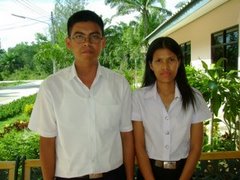Saturday, July 7, 2007
Sunday, July 1, 2007
Friday, June 8, 2007
What we found out on Agendaweb
We found
1. http://www.agendaweb.org/listening/all_levels3.html = 140 SONGS to learn english
3. http://www.agendaweb.org/listening/easy_interm.html = 102 listenings with activities
Saturday, May 19, 2007
Friday, May 11, 2007
April 15 is called, Wan Phaya Wan

Wan Phaya Wan, which is the most important day of the New Year celebration or the Wan Taleung Sok of the central region. There may be also 4 additional days of celebration: April 15th (Wan Paak Pee), April 16th (Wan Paak Deuan), April 17th (Wan Paak Wan), April 18 (Wan Paak Yam) Wan Songkran involves merit making, offering food to monks, listening to sermons, paying respect to elders, and having fun.
April 14 is called, Wan Nao or Wan Da (preparation day)

Wan Nao or Wan Da is an auspicious day when everyone must be cheerful, and must not curse or behave badly. In the morning, food and offerings for the monks are prepared and distributed to friends and relatives in the following morning. In the afternoon, sand is brought to the monastery compounds and sand stupas are created as a form of worship to the Lord Buddha. Finally the time comes for gently splashing water at one another with a word of blessing.
April 13 or Wan Sangkan Long
 Wan Sangkan Long means the old year passes by (Sangkan derived from the word Songkran. Lanna people cannot pronounce double consonants. So Songkran is pronounced Sangkan; Pret is pronounced Pet; Krot is pronounced, Kot.) According to the belief of the northern people, there are Kun Sangkan (a male) and Nang Songkran (a female). On New Year’s day (Sankan Long) a prediction will be announced, similar to the Songkran announcement of the central region, for example, “Sankan Long happens on Sunday with Kun Sangkan, riding on the Naga with a cloud in his hand, moving quickly from the west. Nang Songkran named Siri, holds a cannon, meaning there will be war. Insects will destroy the rice fields. Rain will be abundant. Cattle will fall ill. The wealthy will suffer. White Yang wood is the best quality wood. The spirit of rice lies in the bamboo. Those born on Tuesday will face problems. Those born on Saturday will have good fortune. Red objects and live beings will be costly. White objects will cost less.”
Wan Sangkan Long means the old year passes by (Sangkan derived from the word Songkran. Lanna people cannot pronounce double consonants. So Songkran is pronounced Sangkan; Pret is pronounced Pet; Krot is pronounced, Kot.) According to the belief of the northern people, there are Kun Sangkan (a male) and Nang Songkran (a female). On New Year’s day (Sankan Long) a prediction will be announced, similar to the Songkran announcement of the central region, for example, “Sankan Long happens on Sunday with Kun Sangkan, riding on the Naga with a cloud in his hand, moving quickly from the west. Nang Songkran named Siri, holds a cannon, meaning there will be war. Insects will destroy the rice fields. Rain will be abundant. Cattle will fall ill. The wealthy will suffer. White Yang wood is the best quality wood. The spirit of rice lies in the bamboo. Those born on Tuesday will face problems. Those born on Saturday will have good fortune. Red objects and live beings will be costly. White objects will cost less.”
Saturday, April 21, 2007
Songkran Festival
Songkran Festival is the traditional Thai New Year which starts on April 13 of every year and lasts for three days. It’ s joyous festival. The Thais make merit by giving alms early in the morning or going to the temple to gibe food and offerings to the monks. After that , they may set free bids, fish and turtles as a way to release their sins.
People usually wash themselves and clean their houses during this festival. This symbolizes the cleansing of the soul. There is also custom of bringing sand into the temple compounds and building small sand castles. The Buddhists believe that taking from the temple is sinful and might cause misfortune. Therefore, bringing sand back to the temple is way to return the sand which they have unintentionally carried away on their feet from the temple in the past.
In the afternoon, people gather at the temple to sprinkle scented water on the sacred (or highly respected) Buddha images and statues. They also visit the elderly to ask for a blessing. The most enjoyable part of this festival is taking part in an exciting water – throwing activity in which people splash or pour scented water on the passers – by to freshen them up and also beat the heat of the summertime.
People usually wash themselves and clean their houses during this festival. This symbolizes the cleansing of the soul. There is also custom of bringing sand into the temple compounds and building small sand castles. The Buddhists believe that taking from the temple is sinful and might cause misfortune. Therefore, bringing sand back to the temple is way to return the sand which they have unintentionally carried away on their feet from the temple in the past.
In the afternoon, people gather at the temple to sprinkle scented water on the sacred (or highly respected) Buddha images and statues. They also visit the elderly to ask for a blessing. The most enjoyable part of this festival is taking part in an exciting water – throwing activity in which people splash or pour scented water on the passers – by to freshen them up and also beat the heat of the summertime.
Subscribe to:
Comments (Atom)





